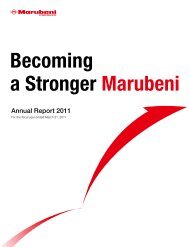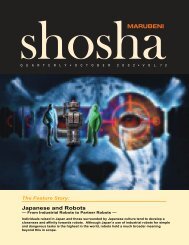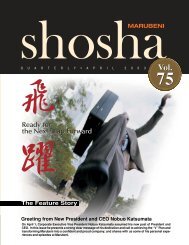Trust Recovery Growth Vitalization - Marubeni
Trust Recovery Growth Vitalization - Marubeni
Trust Recovery Growth Vitalization - Marubeni
Create successful ePaper yourself
Turn your PDF publications into a flip-book with our unique Google optimized e-Paper software.
Notes to Consolidated Financial Statements<br />
maturity. Such amortization and accretion are included in interest<br />
income. Interest on securities classified as held-to-maturity is<br />
included in interest income. Declines in fair value judged to be other<br />
than temporary on held-to-maturity securities are included in<br />
impairment loss on investment securities.<br />
Available-for-sale securities<br />
Marketable equity securities not classified as trading and debt<br />
securities not classified as trading or held-to-maturity are classified as<br />
available-for-sale securities and are carried at fair value, with the<br />
unrealized gains and losses, net of taxes, reported in accumulated<br />
other comprehensive loss in shareholders’ equity. The amortized<br />
cost of debt securities in this category is adjusted for the amortization<br />
of premiums and accretion of discounts to maturity. Such<br />
amortization and accretion are included in interest income. Realized<br />
gains and losses and declines in fair value judged to be other than<br />
temporary on available-for-sale securities are included in gain/loss on<br />
sales of investment securities and impairment loss on investment<br />
securities, respectively. The average cost of securities sold is used in<br />
the determination of realized gains or losses. Interest and dividends<br />
on investment securities classified as available-for-sale are included<br />
in interest income and dividend income, respectively.<br />
Inventories<br />
Inventories, which primarily consist of commodities, merchandise<br />
and real estate held for sale, are stated at the lower of cost (primarily<br />
specific or moving average cost) or market (generally replacement<br />
cost). Inventories included real estate for sale of ¥93,338 million<br />
($872,318 thousand) and ¥106,947 million at March 31, 2005 and<br />
2004, respectively.<br />
Investments<br />
The Companies’ investments in affiliated companies (investees over<br />
which the Companies have the ability to exercise significant<br />
influence) are stated at cost, adjusted for equity in their undistributed<br />
earnings or accumulated losses since acquisition. Other investments<br />
are primarily non-marketable equity securities and are stated at cost,<br />
adjusted for any declines in value judged to be other than temporary.<br />
Loans and allowance for doubtful accounts<br />
Loans including accounts receivable are stated at cost.<br />
In evaluating the credit risk relating to loans, the Companies<br />
categorize them based on the potential exposures for credit ratings<br />
of debtors, geographical and other considerations. When a loan is<br />
impaired, the allowance for credit losses is determined based on<br />
discounted cash flows using the loans’ initial effective interest rate or<br />
the fair value of the collateral for certain collateral dependent loans.<br />
For other loans, the allowance for credit losses is determined based<br />
on a historical bad debt ratio by the credit risk category. When loans<br />
are legally or contractually determined to be uncollectible, the loans<br />
are offset against their respective allowances.<br />
Cash received on impaired loans is either applied against the<br />
principal of such loans or reported as interest income, based on<br />
management’s judgment with regard to the collectibility of the<br />
principal. The Companies discontinue the accrual of interest when<br />
loans are past due for a period of 180 days or more. The accrual of<br />
interest is resumed when agreements for rescheduling of payment is<br />
made and receipt of interest is probable.<br />
Loans ninety days past due are noted as delinquent and monitored<br />
for collectibility. The recorded investments in loans ninety days<br />
past due and still accruing interest were not significant at March 31,<br />
2005 and 2004.<br />
Leases<br />
The Company and certain of its subsidiaries lease fixed assets under<br />
direct financing leases and operating leases as lessors. Income from<br />
direct financing leases is recognized by amortization of unearned<br />
income over the lease term at a constant periodic rate of return on<br />
the net investment. Operating lease income is recognized over the<br />
lease term on a straight-line basis.<br />
The Company and certain of its subsidiaries lease fixed assets<br />
under operating leases and capital leases as lessees. For capital<br />
lease obligations, interest expense is recognized over the lease term<br />
at a constant periodic rate on the lease obligation. Accumulated<br />
depreciation of the leased assets is recognized over the lease term<br />
on a straight-line basis. Rental expense on operating leases is<br />
recognized over the lease term on a straight-line basis.<br />
Depreciation<br />
Depreciation of property, plant and equipment (including property<br />
leased to others) is determined by the declining-balance or the<br />
straight-line method (primarily for buildings) at rates based on the<br />
estimated useful lives of the respective assets, which are from 2 to<br />
50 years.<br />
Mining rights<br />
The FASB issued FASB Emerging Issue Task Force Issue 04-2,<br />
Whether Mineral Rights are Tangible or Intangible Assets (EITF 04-2).<br />
In this regard, the FASB also issued FASB Staff Position (FSP) No.<br />
141-1 and 142-1, which amend SFAS 141 and SFAS142. In accordance<br />
with EITF 04-2 and FSP No. 141-1 and 142-1, all mining rights,<br />
which were previously classified as intangible assets, have been<br />
reclassified in Property, plant and equipment in the consolidated<br />
balance sheets.<br />
Mining rights are primarily amortized by the unit-of-production<br />
method or straight-line method.<br />
Long-lived assets other than goodwill and other intangible assets<br />
Long-lived assets held and used are evaluated for impairment and<br />
written down to their fair value if the sum of their expected future<br />
cash flows is less than the carrying amount of the assets. Long-lived<br />
assets to be disposed of are reported at the lower of the carrying<br />
amount or fair value less cost to sell.<br />
Business combinations<br />
In accordance with Statement of Financial Accounting Standards No.<br />
141, Business Combinations, the purchase method of accounting is<br />
used for all business combinations. The Company separately<br />
recognizes and presents acquired intangible assets as goodwill or<br />
other intangible assets.<br />
Goodwill and other intangible assets<br />
Effective April 1, 2002, the Companies adopted Statement of<br />
Financial Accounting Standards No. 142, Goodwill and Other<br />
Intangible Assets (SFAS 142). SFAS 142 prohibits the amortization of<br />
goodwill and intangible assets with indefinite useful lives. SFAS 142<br />
requires that these assets be reviewed for impairment at least<br />
annually. Intangible assets with finite lives will continue to be<br />
amortized over their estimated useful lives. Additionally, SFAS 142<br />
requires that goodwill included in the carrying value of equity method<br />
investments no longer be amortized. The Companies annually test<br />
goodwill for impairment using the two-step process prescribed in<br />
SFAS 142. The first step is a screen for potential impairment, while<br />
the second step measures the amount of the impairment, if any.


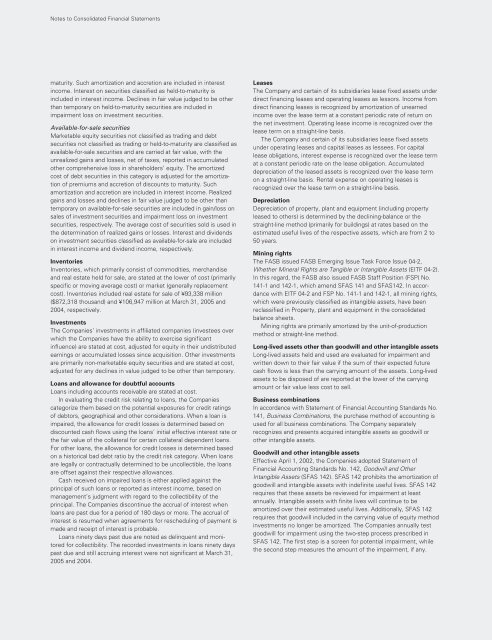
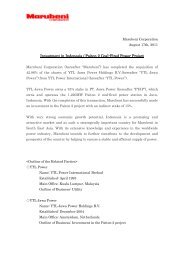
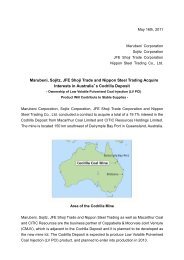
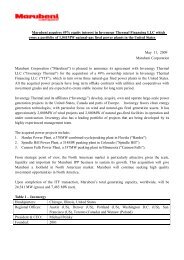
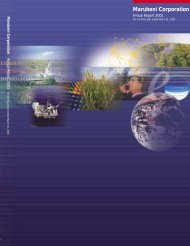
![[Chapter 2] Driving Growth: Expansion Under SG-12 - Marubeni](https://img.yumpu.com/4161147/1/190x248/chapter-2-driving-growth-expansion-under-sg-12-marubeni.jpg?quality=85)
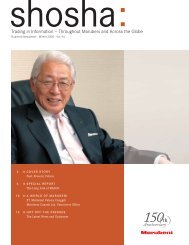

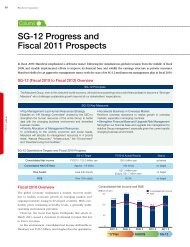
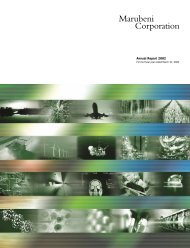
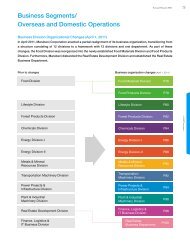
![[Chapter 4] Delivering Growth - Marubeni](https://img.yumpu.com/3464783/1/190x248/chapter-4-delivering-growth-marubeni.jpg?quality=85)
